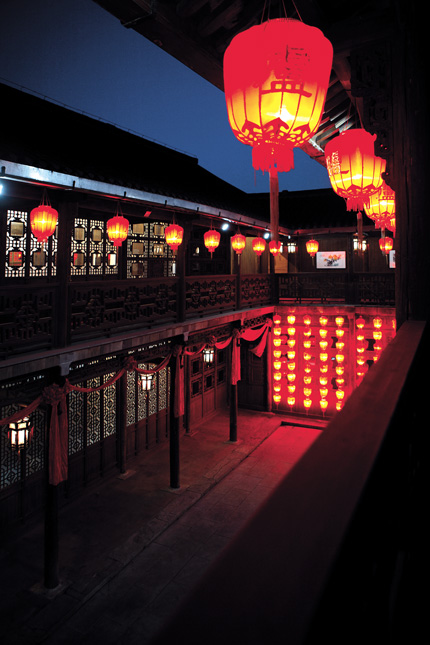
 |
| Red lanterns are hung up high at night in the Dwelling of Lu Shaoxu.(Shanghai Daily) |
The stone bridge has 15 arches.
The grand and rough stone arches in the lower bridge and the refined wooden pavilions above create an intriguing scene suggesting a blossoming lotus from a distance. Thus, it's also known as Lotus Bridge.
This combination of bolder northern Chinese style, as in the arches, and the delicate southern style, as in the pavilions, is present in nearly all Yangzhou gardens, setting them part from the famous Suzhou gardens.
The classical Suzhou gardens and compounds in other southern Chinese cities were mostly built by retired government officials. They said they searched for spiritual peace and designed their gardens to recreate natural beauty and to be places for writing poetry, painting and appreciating the moon and flowers.
Classical gardens
Yangzhou gardens, like the famous Ge Garden by the lake, were mainly constructed by wealthy merchants who wanted to show off their wealth, demonstrate their taste and hold parties where they could also do business. The aim was not solitary leisure, or a gathering of a few kindred spirits to appreciate nature, but social networking that would earn even more money.
Ge Garden was built in 1818 by Huang Zhijun, head of the salt traders association and one of the wealthiest men in the region. The garden is famous for many types of bamboo. The plant is associated with virtue, resoluteness, honor and modesty - the qualities of a refined man. An ancient saying goes, "It's better to eat without meat than to live without bamboo."
The name Ge also comes from bamboo, as the character looks like three bamboo leaves; it also is half of the character zhu, which means bamboo. It is considered one of the best gardens in Yangzhou for its clear display of the four seasons through artificial scenes.
For example, in a shady corner of the garden that never gets sun, the ground is covered with white stones to represent snow. A high adjacent wall contains 24 openings, creating the sound of wind in winter.
Wang's Small Garden, not far from Ge Garden, was built by salt trader Wang Zhuming (1860-1928), who became the manager of a salt trading house at the age of 30. As salt trading and canal transport became difficult during times of conflict and railway expansion, Wang's children left Yangzhou for Shanghai and took up real estate and retail. That shift was typical for salt traders then.
















 Heavy snowstorm wreaks havoc in NE China
Heavy snowstorm wreaks havoc in NE China


![]()
